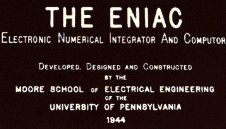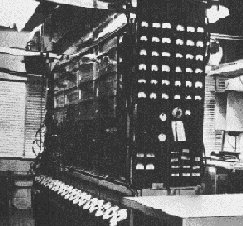|
The Electromechanical Calculators
In the thirties a lot of cards tabulator machines' installations are carried out at the major companies. A real scientific and cultural revolution arises.
The punch cards machines' development starts, and the scientists tries to "invent" some devices which are able to execute faster calculations.
The immediate post-war period was the suitable moment for a fast development of the calculation machine's technology.
The origin of this change is a little mechanism created for the radio, the valve, which is able to quicken the calculus processes machine's.
Under the war incentive in 1938 the german engineer Zuse built the first mechanical calculation machine in the history, the Z1, then followed in 1939 the Z2, it was the first electromechanic calculation machine and it used 2600 relays, and then the Z3 which was also electromechanic and it was used for war aims until the fall of the Nazi Germany.
The Z3 executed the four operations and the square root.
In 1944, seven years later, it was realizzed by Horward H. Aiken at the Harvard University, the first United Stated electromechanic calculation machine, the Mark 1, which is faster than the Z3.
The Mark 1, in addiction to the four operations, it executed also the logarithm, exponential and trigonometric calculus.
The calculation machine is guided by a series of instructions, which are represented by holes on a paper band or on punch cards or by a on-off switch operated by hand.
Reading these instructions and the introduced by punch cards data, the machine goes on autonomous without man intervention and it gives the results, punching them on cards or on print through the electric typewriters.
The Mark 1 is familiarly called "Bessie" and it is composed by 78 calculation machines connected by 800 kilometres of electric wires and it contains more than 3000 relays.
The relays start the mechanical parts, like wheel counters, it weighs 5 tons and it is able to add two numbers of 23 digits in 3 tenth of seconds or to multiply them in approximately 6 seconds, it costed 400.000 dollars.
In 1946 the ENIAC (Electronic Numerical Integrator And Computer) starts at the Pennsylvania University, it is the first digital calculation machine with valves and that means the beginning of the "Electronic Generation".
Its architect, J. Presper Eckert, excluded all the mechanic components, and he replaced them with empty tubes which starts through electric impulses and which
indicates the various digits thruogh the state "on" or "off".
As the electronic impulses move thousands of times quicker than an electromeccanic device , the ENIAC is able to put into practice more than 300 multiplications in one
second.
The first electronic calculation machine in the history uses 18.000 valves, it weights 13 tons and it takes a surface of 180 square metres.
The inner operations time, were calculated by the electronic impulses which were given with a rhythm of 100.000 per second.
Increasing the calculus speed it was necessary to speed up the programming work.
Before working on a program, the ENIAC had to be prepared by an engineers team who for some days worked to connect by hand the electric circuits which were nesessary for that program.
The ENIAC worked until 1955 and it is actually exhibited at the Washington Smithsonian Institute.
By a project of an Ungarian scientist, John von Neumann, in 1949 the EDSAC (Electronic Delay Storage Automatic Calculator) starts in Cambridge, England and then in 1950 the EDVAC starts at the Princeton Advanced Studies Institute,
USA, and this is what was recognized as the real prototype of the modern electronic calculation machines.
The new machines, are based on the concept of "memory program", it means that, in its own "Memory", not only the data on which is possible to work, are set, but also its operating directions.
So the calculation machine, during the course of an elaboration, basing on the intermediate issues' tests, can jump directly from an opereting to an other, executing so different operations and according to the various necessity it is possible to solve different kinds of problems.
The machine becomes a "calculation machine", which is able to execute not only arithmetical operations at high speed, but also to take logic decisions which are forseen by a human program, elaborating so every kind of information.
The combination of these two features allows to alter the normal operating's sequence basing itself on the comparison's issue: it allows to transfer control directions which before required an human intervention.
|


















